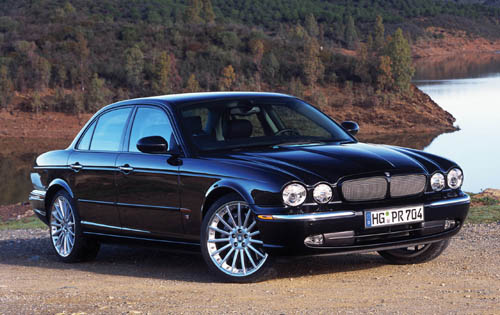1/24/11
The Series II models were known for their poor build quality, which was attributed to Jaguar being part of the British Leyland group, as well as to problems inherent in the design of certain Lucas-sourced components.
Initially the Series II was offered with two wheel bases, but at the 1974 London Motor Show Jaguar announced the withdrawal of the 'standard wheel base' version: subsequent saloons/sedans all featured the extra 4 inches (10 cm) of passenger cabin length hitherto featured only by the 'long wheel base' model.By this time the first customer deliveries of the two door coupe, which retained the shorter 'standard' wheel base (and which had already been formally 'launched' more than a year earlier) were only months away.
Visually, Series II cars are differentiated from their predecessors by raised front bumpers to meet US crash safety regulations, which necessitated a smaller grille, complemented by a discrete additional inlet directly below the bumper. The interior received a substantial update, including simplified heating and a/c systems to address criticisms of the complex and not very effective Series I system.
In April 1975 the North American Series II got a slightly revised set of front bumpers which had rubber overriders covering the full length of the bumper with embedded turn signals at each end. In 1978 the North American cars also got the addition of electronic fuel injection in the place of Zenith-Stromberg carburettors.
In May 1977 it was announced that automatic transmission version of the 12 cylinder cars would be fitted with a General Motors three speed THM 400 transmission in place of the British built Borg-Warner units used hitherto.
The 1978 UK model range included the Jaguar XJ 3.4, XJ 4.2, XJ 5.3, Daimler Sovereign 4.2, Double-Six 5.3, Daimler Vanden Plas 4.2, Double-Six Vanden Plas 5.3.
In New Zealand, CKD kits of the Series II were assembled locally by the New Zealand Motor Corporation (NZMC) at their Nelson plant. In the last year of production in New Zealand (1978), a special 'SuperJag' model was produced which featured half leather, half dralon wide pleat seats, vinyl roof, chrome steel wheels and air conditioning as standard. New Zealand produced models featured speedometers in km/h, and the black vinyl mats sown onto the carpets in the front footwells featured the British Leyland 'L' logo.
Though worldwide production of the Series II ended in 1979, a number were produced in Cape Town, South Africa until 1981.
A total of 91,227 Series II models were produced, 14,226 of them with the V12 engine.
 Jaguar XJR Full Size Wallpaper
Jaguar XJR Full Size Wallpaper Jaguar XJR
Jaguar XJR Jaguar XJR
Jaguar XJR Jaguar XJR
Jaguar XJR Jaguar XJR
Jaguar XJR





0 comments:
Post a Comment